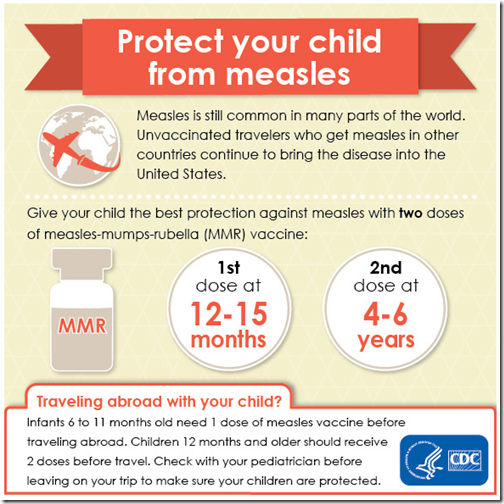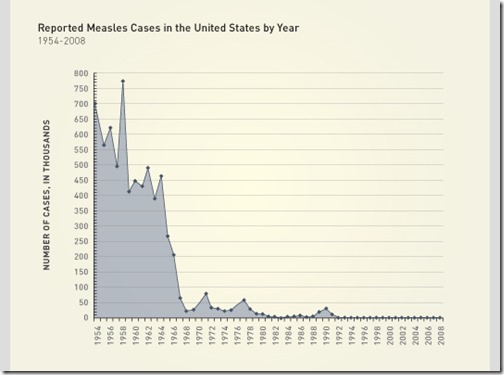The Centers for Disease Control and Prevention (CDC) has a page on measles vaccination. As someone who had measles in 1971, after being vaccinated in 1969, I spent some time this week researching measles to find out what happened to me.
CDC recommends MMR Vaccination for infants traveling international
My personal interest turned into this article after reading the CDC website and learning that the CDC recommendation for children who travel internationally from 6 months to 11 months is to receive one dose of MMR vaccine. Infants then need another dose after 12 months of age followed by a second dose more than 28 days later, before traveling
http://www.cdc.gov/features/measles/
Children who travel abroad are recommended to have an accelerated vaccination regime.
Make Sure You’re Protected against Measles before International Travel
Before any international travel—
- Infants 6 months through 11 months of age should receive one dose of MMR vaccine.†
- Children 12 months of age and older should receive two doses of MMR vaccine separated by at least 28 days.
- Teenagers and adults who do not have evidence of immunity* against measles should get two doses of MMR vaccine separated by at least 28 days.
† Infants who get one dose of MMR vaccine before their first birthday should get two more doses (one dose at 12 through 15 months of age and another dose at least 28 days later).
* Acceptable presumptive evidence of immunity against measles includes at least one of the following: written documentation of adequate vaccination, laboratory evidence of immunity, laboratory confirmation of measles, or birth in the United States before 1957.
From 1954 to 1964 there were about 400,000 to 800,000 per year reported measles cases in the U.S. before the first measles vaccines were developed in the early 1960s. By 1968, after a few years of measles vaccinations, the reported cases of measles dropped to the low tens of thousands with a spike in 1971 and 1977 to over 50,000 reported cases. In the past 20 years measles was virtually eradicated in the USA with fewer than 100 reported cases per year for most years.
Buzzfeed.com has an article with 9 charts to explain the current measles outbreak.
The CDC chart shows that 2014 had over 600 reported cases of measles. This is a much higher incidence than most years since 2001 with under 100 cases per year. Obviously measles vaccinations have kept the highly contagious disease in check in the USA.
Measles spreads through the air, and is one of the most contagious and easily transmitted diseases there is. When one person gets measles, it can be expected that they will pass it on to 12 to 15 other unprotected people. And each of those 12 to 15 unprotected people can pass it along to 12 to 15 more. And so on.
Measles risk for international travelers
Currently there are CDC measles watches for Philippines and Vietnam. The Philippines had nearly 57,574 suspected cases of measles in 2014, including 21,403 confirmed cases of measles and 110 deaths.
CDC recommends that travelers to the Philippines protect themselves by making sure they are vaccinated against measles, particularly infants 6–11 months of age (1 dose of measles vaccine) and children 12 months of age or older (2 doses of measles vaccine). http://wwwnc.cdc.gov/travel/notices/watch/measles-philippines
Vietnam in 2014 had 17,267 suspected cases of measles, including 5,568 confirmed cases and 2 deaths.
Don’t think travel in Europe is safe from measles exposure. In Austria, fewer than 80% of residents have had a measles vaccine. Source: European Centre for Disease Control and Prevention. The USA is around 91%.
Between January and March 2011, there were 6,500 cases of measles reported in 33 European countries. France had 4,937 cases. World Health Organization pinned the measles outbreak in large part due to children aged 10 to 19 who had never been vaccinated for measles. It is estimated that 90% of people who are not vaccinated will develop measles if they come into contact with the airborne virus.
Children of the 1960s were vaccine guinea pigs
All this talk of measles recently had me wondering about my own vaccination history. As a military brat in the 1960s, moving every single year from one state to another and over to Germany in 1969, our family had numerous vaccinations.
The current controversy is about the MMR vaccine for measles, mumps and rubella. That vaccine went to market in 1971. It is considered highly effective.
Between 1967 and 1971, I suffered through all three diseases of Rubella, Mumps and Measles. My diseases started with Rubella in 1967 when my parents noticed I was breaking out in a rash while watching a show at SeaWorld San Diego. There were no major media reports at the time to trace an epidemic of Rubella to SeaWorld and me.
In 1969, I came down with Mumps. Apparently, my sister had the mumps after me and my mother thinks my sister traveled with the mumps on an airplane from Germany back to the USA. The army doctor cleared her for travel stating she did not have mumps. My father was shipping out to Vietnam. It would have been a big hassle to stay in Germany for an additional two to three weeks after we had moved out of our military housing unit. I think sometimes a lack of paperwork was the strategy to expedite military maneuvers. The airline and Center for Disease Control did not go on high alert from my sister’s illness. After all, this was still the 1960s.
The disease I remember most clearly was measles, which I contracted when I was almost 12 years old. Being an avid reader in grade school, my sixth grade bout with measles gave me a couple of weeks to lay in bed reading books. The one distinct memory I have from the measles quarantine period is when my father came home from Vietnam and gave me a Reader’s Digest article to read listing probabilities for permanent deleterious effects like brain damage, pneumonia and death.
The CDC website currently states one or two people die on average for every 1,000 measles cases.
My question this past week is why did I get measles in 1971 when I had been vaccinated for measles in 1969?
According to the CDC, vaccines in the 1960s were not necessarily effective. In 1971 there was a spike in measles outbreaks. Turns out I was a recipient of one of those ineffective live measles vaccines in 1969. Two years later I came down with measles.
http://www.historyofvaccines.org/content/graph-us-measles-cases
In the end, I am still here. Childhood diseases of measles, mumps and rubella were common events in the USA before 1971.
Vaccines have nearly eliminated these three diseases in the USA today with annual cases in the low hundreds nationwide, rather than hundred thousands.
Protect your infant children with the CDC recommended vaccines before international travel. These diseases, still prevalent in many countries, tend to have more severe effects on infants.






3 Comments
Comments are closed.